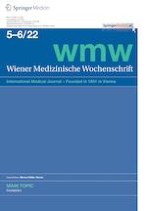12.08.2021 | original article
Food additive E407a stimulates eryptosis in a dose-dependent manner
Erschienen in: Wiener Medizinische Wochenschrift | Ausgabe 5-6/2022
Einloggen, um Zugang zu erhaltenSummary
Background
Concerns about the biosafety of the common food additive E407a have been raised. It has been demonstrated to induce intestinal inflammation, accompanied by activation of apoptosis, upon oral exposure. Thus, it is of interest to investigate how E407a affects eryptosis, a suicidal cell death mode of red blood cells.
Objective
To evaluate the effects of semi-refined carrageenan (E407a) on eryptosis.
Methods
Flow cytometry was employed to assess eryptosis in blood exposed to various concentrations of E407a (0 g/L, 1 g/L, 5 g/L, and 10 g/L) during incubation for 24 h by analyzing phosphatidylserine externalization in erythrocytes using annexin V staining and via evaluating reactive oxygen species (ROS) generation using 2′,7′-dichlorodihydrofluorescein diacetate (H2DCFDA). In addition, the eryptosis indices mentioned above were determined in rats orally administered E407a at a dose of 140 mg/kg weight for 2 weeks. Confocal scanning laser microscopy was performed to visualize cell membrane scrambling.
Results
Oral intake of E407a for 2 weeks by rats was not associated with membrane scrambling in erythrocytes. However, ROS overproduction was observed. Meanwhile, incubation of blood with various concentrations of semi-refined carrageenan resulted in a dose-dependent promotion of eryptosis, evidenced by the enhanced percentage of annexin V-positive erythrocytes and higher mean fluorescence intensity (MFI) values of annexin V-FITC in all erythrocytes. The highest concentration of E407a promotes a statistically significant increase in ROS generation in erythrocytes, suggesting the role of ROS-mediated induction of eryptosis in this case.
Conclusion
Incubation of blood with the food additive E407a leads to the activation of eryptosis in a dose-dependent manner. ROS-mediated mechanisms are partially responsible for E407a-induced eryptosis.
Anzeige
